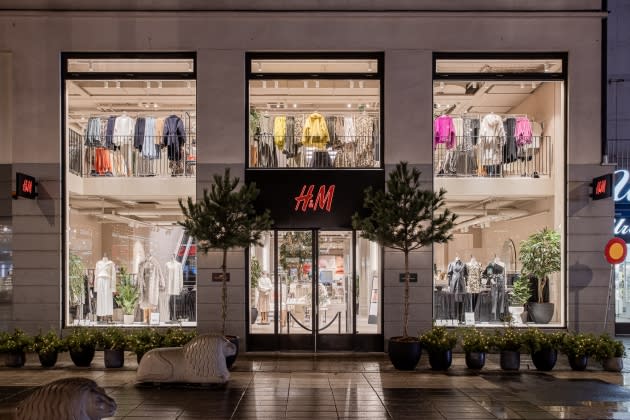H&M Plans to Double Sales, Halve Carbon Footprint by 2030

PARIS — H&M Group is prepping for growth — of the circular kind.
The Swedish fast-fashion retailer revealed plans to ramp up its sustainability drive while at the same time aiming to double its revenues by 2030.
More from WWD
The ambitious program will involve accelerating circularity, investing more in sustainable materials and helping suppliers reduce their environmental impact, said chief executive officer Helena Helmersson, who has headed the company since early 2020, during the company’s full-year conference call Friday morning.
The 2030 sales target — which would require sales increases of between 10 and 15 percent annually — is to be based on 2021 numbers, while the sustainability target will work from a 2019 baseline.
“Our strong recovery continues,” Helmersson told analysts and journalists. “Despite the tough challenges, we have been able to end the year strongly, with sales back at the same level as before the pandemic and with better profitability.
“After nearly two years focusing on managing a difficult situation, we have recovered well. We’re back to a more normalized situation with a strong financial position and good profitability. That means we can go back to focusing fully on growth again.”
She continued, “It’s a very ambitious goal that we’re determined to achieve.”
In the short term, H&M Group, which operates Cos, Monki, & Other Stories, Arket and Weekday as well as its core banner, will double its investments this year, it said. For 2022, the retailer revealed capital expenditures of around 10 billion Swedish kronor, or $1.07 billion.
While the company’s major focus will be on the H&M brand, it will also invest in its other brands and initiatives including its investment arm Co:Lab, through which it has so far bought into around 20 start-ups focusing on the customer experience and sustainable technologies and materials to make the group’s business more environmentally sound.
Of the sums allocated for investment this year, some 3 billion Swedish kronor, or $320.1 million, will go toward developing more sustainable materials and transitioning to renewable energies, Helmersson said.
“Not only are we going to secure that customers all over the globe can make sustainable choices when they choose fashion and design, but also we will make sure that we grow within the planetary boundaries,” she said. “We don’t mean doubling the volumes, we mean doubling the revenues, it’s about decoupling our growth with carbon and the climate.”
The company will be investing to help its suppliers integrate more sustainable processes and transition to renewable energies, she said, as well as ramping up the use of more sustainable fibers.
“The fibers in the garment, we should be able to use them over and over again,” she said, adding that the company would gradually integrate renewable fibers from companies in which it has invested to promote circularity.
It will be deploying its Circulator eco-design tool, introduced last year to help its teams make more sustainable choices at the design stage, to other brands in the portfolio, Helmersson said.
Resale will be another area of focus. “Resale is on the rise. More and more customers in certain parts of the world want to buy second-hand,” she said.
“One product can have several transactions, meaning, for example, when we connect Sellpy with H&M.com, we can also ensure that we have more durability and that each product has a longer life,” she added, referring to the resale platform in which H&M bought a majority stake in 2019.
In the fast-fashion space, H&M had been lagging compared with its larger competitor Inditex in recent months. But its latest figures showed that it has bounced back, with profitability gains. Inditex is to report its results for its year ending Jan. 31 in mid-March.
For the year ended Nov. 30, H&M reported operating profit of 15.26 billion Swedish kronor, or $1.63 billion at current exchange, up 392 percent compared with the 3.1 billion Swedish kronor, or $331.2 million, figure it reported for 2020.
Net profit for the 12 months stood at 11.01 billion Swedish kronor, or $1.18 billion, up from 1.24 billion Swedish kronor, or $132.5 million a year earlier.
H&M Group logged annual sales of 198.96 billion Swedish kronor, or $21.26 billion, up 6.4 percent in reported terms on 2020, as reported.
The market reacted positively, sending H&M shares up 5.7 percent to 188.86 Swedish kronor, or $20.18, in midday trading.
Key to H&M’s turnaround efforts has been increasing sales of the full-price offer, and the company has made significant progress in recent months, said investor relations head Nils Vinge during the call.
“Markdowns came in below what we guided for,” he said. “For the first quarter, they will continue to be below last year’s numbers.”
Helmersson also addressed the supply-chain headwinds that have impacted the industry over the past year. “We do think that the worst is behind us right now,” she said. “Making sure that we have diverse supply chains is absolutely crucial. We will develop the supply chain further to be even more flexible going forward.”
H&M plans to close 120 stores net this year, the company said, mainly in Europe. “We still have great potential outside Europe,” Helmersson added, declining to answer questions about the impact of the boycott the company has been facing in China over its stance on Xinjiang cotton.
Sign up for WWD's Newsletter. For the latest news, follow us on Twitter, Facebook, and Instagram.
